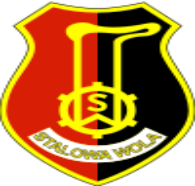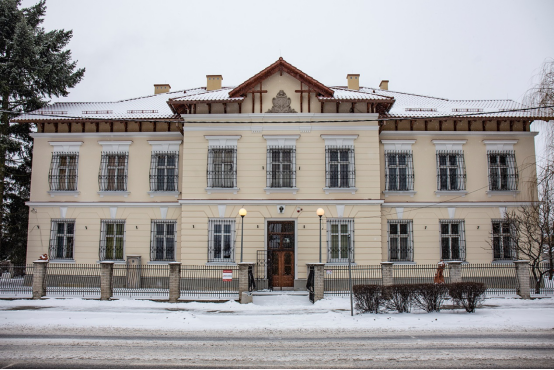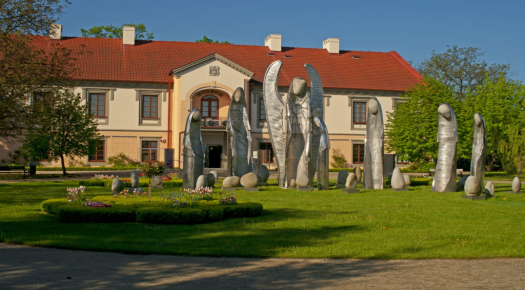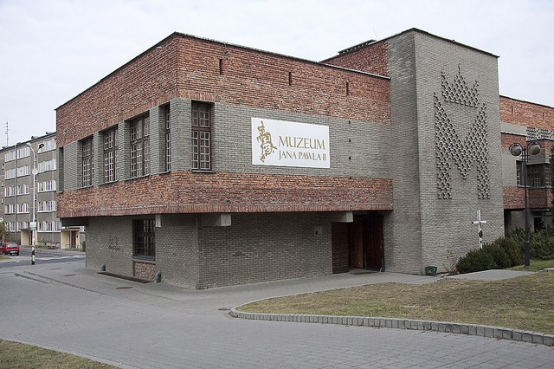Stalowa Wola- Subcarpathian 作者: 来源: 发布时间:2021-10-25
Population and Area
Ⅰ. Population and Area
Population (2019)
• City 60,799
• Density 740/km2 (1,900/sq mi)
Area
City 82.5 km2 (31.9 sq mi)
Website http://www.stalowawola.pl

Ⅱ.Natural Geography (environment and resources)
-Stalowa Wola lies in the lowlands of the Sandomierz Basin, near the San river. On January 1, 2010, the area of the town was 82 square kilometres (32 square miles) and 60% of Stalowa Wola was covered by pine forests, remnants of the once enormous Sandomierz Forest. The name of the town (Stalowa Wola can be translated into English as “steel will”) comes from words of General Tadeusz Kasprzycki, Minister of Military Affairs of Poland, who stated in the late 1930s that the Central Industrial Area symbolizes the steel will of the Polish nation to modernize itself.
Transport
-Polish State Railways (PKP) provides scheduled connections to Lublin, Warsaw, Kraków, Katowice, Wrocław, Rzeszów, Przemyśl and Odessa (in Ukraine). Summer connections are available to the TriCity (Gdańsk, Gdynia and Sopot) and Hel. The city has several railway stations that include: Stalowa Wola, Stalowa Wola South, Stalowa Wola Centre and Stalowa Wola Rozwadów,[2] and is a main rail junction. All four stations are located on the main Przeworsk – Skarżysko-Kamienna line. Additionally, Stalowa Wola Rozwadów provides a northern connection with Lublin and, from Stalowa Wola South, a line runs east to Zamość, via Zwierzyniec. The ZMKS is the city's main public transit agency, operating a fleet of buses in Stalowa Wola and the surrounding districts.
Ⅲ.Economy
-The steel mill (HSW S.A.) was a major part of a series of investments made by the Polish government between 1936 and 1939 to create the Central Industrial Region. This was to be a group of factories built in an area in the middle of the country, away from the borders with Germany and the USSR. It was designed to provide a reasonably secure location for the production of armaments and high technology goods. The main employer is still HSW S.A. (manufacturer of heavy machines and hi-quality alloys). Other large enterprises include StahlSchmidt (producer of aluminium rims), ESW (coal power plant), Prefabet Stalowa Wola (building materials) and Mostostal S.A. (steel construction-bridges, tanks and so on).
-Stalowa Wola - Wikipedia https://en.wikipedia.org/wiki/Stalowa_Wola#Economy
Economy - Development Strategy for the City of Stalowa Wola for 2016-2022
The number and structure of economic entities
The city of Stalowa Wola stands out from the Podkarpackie Province with a large number of business entities per 10,000 inhabitants of working age. This indicator increased in the years by 5.9% - from 1452.6 to 1538.0. These values are a few percent lower than the national average, where 1,700.2 business entities are per 10,000 inhabitants, which is an increase of 7.4% compared to 2010.
Table 103. Economic entities per 10,000 inhabitants of working age
2010 | 2011 | 2012 | 2013 | 2014 | change | |
Poland | 1574.6 | 1564.3 | 1615.6 | 1666.6 | 1700.2 | 7.4% |
voiv. Podkarpackie Province | 1123.1 | 1110.8 | 1140.3 | 1177.6 | 1202.9 | 6.6% |
Stalowa Wola district | 1210.2 | 1197.5 | 1228.5 | 1254.6 | 1283.1 | 5.7% |
Stalowa Wola | 1452.6 | 1429.0 | 1468.7 | 1500.1 | 1538.0 | 5.9% |
Source: Local Data Bank of the Central Statistical Office
Comparing Stalowa Wola with selected cities in the Podkarpackie Province, it can be seen that the number of business entities per 10,000 inhabitants of working age is definitely higher than in Dębica and Sanok, but lower than in Mielec. The greatest dynamics of changes was recorded in the years 2010-2014 in Mielec - by 10.4%, a greater increase in business entities (compared to Stalowa Wola) is also recorded in Dębica - 6.6%.
Table 104. Economic entities per 10,000 inhabitants of working age in Stalowa Wola and reference units
2010 | 2011 | 2012 | 2013 | 2014 | change | |
Sanok | 1450.1 | 1427.6 | 1436.1 | 1488.9 | 1507.6 | 4.0% |
Debica | 1315.1 | 1295.9 | 1313.0 | 1362.7 | 1401.4 | 6.6% |
Mielec | 1441.5 | 1444.6 | 1495.9 | 1553.3 | 1590.8 | 10.4% |
Stalowa Wola | 1452.6 | 1429.0 | 1468.7 | 1500.1 | 1538.0 | 5.9% |
Source: Local Data Bank of the Central Statistical Office
The total number of business entities in Stalowa Wola slightly decreased in 2010-2014. The city is dominated by economic entities employing up to 9 people, ie micro-enterprises, of which there are about 6,000. A decrease in the number of small enterprises employing from 10 to 49 people was particularly visible. It amounted to 13.4% - from 237 entities in 2010 to 209 in 2014. The number of medium-sized enterprises fluctuated insignificantly, oscillating around 70, similarly large entities - employing over 250 people, of which there were around 16 in the entire analyzed period. the number is 3.
Table 105. Number of economic entities by size class in the city of Stalowa Wola
number of employees | 2010 | 2011 | 2012 | 2013 | 2014 | change |
0-9 | 6074 | 5874 | 5929 | 5927 | 5935 | -2.3% |
10-49 | 237 | 229 | 204 | 199 | 209 | -13.4% |
50-249 | 69 | 71 | 72 | 71 | 68 | -1.5% |
Source: Local Data Bank of the Central Statistical Office
·Activity profiles dominating in the economy
Most of the Stalowa Wola business entities are engaged in activities that belong to the third sector of the economy, i.e. broadly understood services. Their number stabilized at 5,180, and in 2010 there were 5,335. The number of enterprises operating in the second sector - industry and construction - was also the highest in 2010 and amounted to 1,039, and by 2014 it slightly decreased - to 1,027 enterprises. The least numerous activities are agriculture, forestry and fishery, which were employed by 21 (in 2014) to 24 (in 2013) economic entities.
Chart 9. The number of economic entities from Stalowa Wola by groups of PKD sections in 2010-2014
Source: Local Data Bank of the Central Statistical Office
The majority of companies operating in Stalowa Wola are wholesale and retail trade and repair of motor vehicles, including motorcycles, despite a significant decrease in their number in 2010-2014 - from 2,367 to 2,130. Construction is another large industry group - the number of economic entities in 2010-2014 it oscillated around 560. The next highly represented profile is professional, scientific and technical activity, and its share in the number of economic entities of the commune increased from 8.6% to 9.0% (from 547 to 558). The smallest were enterprises dealing with mining and quarrying (2-3 entities), production and supply of electricity, gas, steam, hot water and air for air conditioning systems (3-4 enterprises), as well as water supply, sewage management and waste,
Table 106. The number of economic entities in Stalowa Wola broken down by the profile of activity according to sections of PKD 2007
PKD section | 2009 | 2010 | 2011 | 2012 | 2013 |
agriculture, forestry, hunting and fishing | 22 | 23 | 23 | 24 | 21 |
mining and quarrying | 3 | 3 | 2 | 2 | 3 |
industrial processing | 445 | 433 | 445 | 439 | 447 |
production and supply of electricity, gas, steam, hot water and air for air conditioning systems | 4 | 3 | 3 | 4 | 4 |
water supply; sewerage, waste management and remediation activities | 6 | 8 | 9 | 10 | 11 |
construction | 581 | 563 | 578 | 559 | 562 |
wholesale and retail trade; repair of motor vehicles, including motorcycles | 2367 | 2255 | 2203 | 2180 | 2130 |
transport and warehouse management | 337 | 318 | 320 | 332 | 330 |
activities related to accommodation and catering services | 212 | 212 | 201 | 194 | 193 |
information and communication | 125 | 130 | 131 | 132 | 134 |
financial and insurance activities | 266 | 246 | 240 | 230 | 222 |
real estate activities | 288 | 296 | 303 | 304 | 311 |
professional, scientific and technical activities | 547 | 521 | 528 | 543 | 558 |
activities in the field of administration services and supporting activities, public administration and national defense; compulsory social security | 121 | 121 | 129 | 130 | 132 |
education | 214 | 204 | 232 | 239 | 245 |
health care and social assistance | 333 | 328 | 354 | 368 | 379 |
activities related to culture, entertainment and recreation | 95 | 95 | 89 | 83 | 90 |
other services | 430 | 430 | 431 | 440 | 456 |
Source: own study based on the BDL CSO
Economy - Stalowa Wola - the official website of the city http://www.stalowawola.pl/dla-biznesu/gospodarka/
Ⅳ.Industrial Characteristics
-The city grew naturally next to the metallurgical and mechanical plants erected as part of the Central Industrial District project. The plan of the Polish authorities, implemented in the 1930s, aimed at rearmament and modernization of the army, when in the face of difficulties with obtaining supplies from abroad, it was more advantageous to create own production plants for this purpose, which also resulted in improved industrialization of the country and had an impact on its economic development . The assumptions of this concept were included in a memorial prepared by the economist Władysław Kosieradzki and his brother Paweł, who dealt with industrial issues (1936). Selected location, in the so-called in the security triangle, it was to ensure the appropriate distance from the borders, and thus from potential war threats. The then Deputy Prime Minister and Minister of the Treasury, Eugeniusz Kwiatkowski, was responsible for the implementation of the project, while on behalf of the army it was supervised by Deputy Minister General Aleksander Litwinowicz. As part of the centralization of the COP, it was intended to create a new voivodeship of Sandomierz, referring to the tradition, and make Stefan Starzyński its voivode.
-Today, Stalowa Wola is still one of the youngest Polish cities, heirs of the more and more appreciated COP tradition of "good work", today constantly modernizing its image, developing dynamically and in many directions.
-Key Projects
-1. Modeling of comprehensive revitalization of Stalowa Wola with the use of social participation tools
-It is worth mentioning that the revitalization project - Modeling of comprehensive revitalization of Stalowa Wola with the use of social participation tools , which was submitted by the commune to the competition of the Ministry of Infrastructure and Development - Model Urban Revitalization, was very highly rated and qualified for the second stage
-Economy - Stalowa Wola - the official website of the city http://www.stalowawola.pl/dla-biznesu/gospodarka/
Ⅴ.Attrations and Cityscape
-The Alfons Karpiński Painting Gallery in Stalowa Wola
-The Regional Museum in Stalowa Wola has opened the country's first gallery of paintings by Alfons Karpiński, one of the leading artists of the Young Poland period. Located in the former court building in Rozwadów (today the Stalowa Wola estate), it presents one of the best collections devoted to this artist in a modern way. Rozwadów is the place where the painter Alfons Karpiński was born and spent his first years of life. The gallery is a new and unique place on the map of Podkarpacie, which has set itself the goal of innovative education in the field of art.
-The Alfons Karpiński Painting Gallery is located in the historic building of the former court. This magnificent building was erected in 1905 on the initiative of the Austrian partitioning powers and is a document of representative urban development of the former town of Rozwadów.

-Regional Museum in Stalowa Wola
-The Regional Museum in Stalowa Wola is located in the neoclassical "Lubomirski Castle" from the 18th century, surrounded by a stylish garden. The main building has been adapted to the needs of the disabled. There is a guarded car park next to it. The building houses a Tourist Information Point, a shop and a cafe. The museum collects and provides exhibits related to the history of the region, the history of Stalowa Wola, a collection of works by Alfons Karpiński and Stefan Norblin, as well as art deco items. It organizes numerous temporary exhibitions, especially in the field of art, promotes Polish creators of modern design in Poland and Europe, paves the way for cultural tourism, and conducts extensive publishing activities. The museum conducts educational and artistic classes.

-Museum of John Paul II
-The John Paul II Museum was established on November 4, 2009 by a decree of Fr. Krzysztof Nitkiewicz, Bishop of Sandomierz. The collection is based on the collections of Fr. prof. Wilhelm Gaj-Piotrowski, the main originator of the Museum. Works on the creation of the Museum were entrusted to the co-cathedral parish, the Stalowa Wola Chapter, and the Diocesan Museum in Sandomierz in cooperation with the Regional Museum in Stalowa Wola. The art arrangement is the work of the Warsaw designer Anna Skołożyńska-Cieciera. The team implementing this project was headed by His Excellency, Fr. Bishop Edward Frankowski, a long-time chaplain at the church of Our Lady Queen of Poland in Stalowa Wola, where the Museum is located (Catechetical House, ground floor).
-The exhibition resembles the papal teaching as a spiritual testament, included in thematic lessons: man, homeland, Church, family, youth, love, forgiveness, peace, freedom, joy, dialogue. Large-format photographs and quotations from papal speeches illustrate the issues presented. Against this background, souvenirs related to St. John Paul II. The educational value of the exhibition increases thanks to film projections in a specially designated room. The relationship between John Paul II and Stalowa Wola, dating from the time when, as Archbishop of Kraków, consecrated the Stalowa Wola church in 1973, was also shown.

Ⅵ.History and Culture
-The area of today's Stalowa Wola belongs to historic Polish province of Lesser Poland. In the Kingdom of Poland, it was located in the south-eastern corner of the Sandomierz Voivodeship, near the border with Red Ruthenia. The city of Stalowa Wola was built on the site where the village of Pławo once stood, between the ancient towns of Nisko and Rozwadów. The first mentions of Pławo come from the first half of the 15th century. At the nearby village of Przyszów, there was a hunting lodge of King Władysław Jagiełło, built before 1358. In the late 15th century, Pławo was a royal village. In 1656, the area of Pławo was the site of a battle between Polish and Swedish armies. Here, in the confluence of the San and Vistula, Swedish troops of King Charles Gustav were surrounded by Stefan Czarniecki (see Swedish invasion of Poland).
-Until the Partitions of Poland, Pławo belonged to Sandomierz Voivodeship. From 1772 to 1918, it was part of the Austrian province of Galicia and remained an insignificant, privately-owned village. In early 1937, the government of the Second Polish Republic accepted the project of the Central Industrial Area, which included the construction of a brand new steel mill, together with a settlement for the workers. Before the outbreak of World War II, some departments of the mill were operational and several blocks of flats were built. Construction of the Southern Works, as the mill was then called, was started in dense pine forests around Pławo in March 1937. Among other things, the plant manufactured artillery cannons.
-During World War II, Stalowa Wola was one of the centres of the Home Army. The settlement was captured by the Red Army in August 1944, and on April 1, 1945, Stalowa Wola received its town charter. In 1948, the mill was renamed as Huta Stalowa Wola and in 1953, a separate urban county of Stalowa Wola was created. In 1973, the town of Rozwadów was annexed, followed in 1977 by the village of Charzewice. At its peak in the 1970s, the mill employed 35,000 people, with branches scattered across southern Poland, from Radomsko to Strzyżów. Apart from the mill, Stalowa Wola has a large power plant, opened Spring 1939. In 1988, the city was one of the centres of workers' protests (see 1988 Polish strikes). Currently, Stalowa Wola is the third-largest city of the voivodeship, with a population of 60,000.
-Jews in Rozwadów (a district of Stalowa Wola)
-The Rozwadów suburb of Stalowa Wola was a thriving Jewish shtetl prior to World War II and was closely associated with Tarnobrzeg and other nearby shtetls including Ulanów, Mielec, Dzików etc. These communities, infused with vitality before 1939, were utterly destroyed during the Holocaust after having been affected by World War I only some 20 years earlier. Jews in Rozwadów were a religiously observant community, i.e. traditional or Orthodox in practice. The leading rabbi of Rozwadów, similar to other rabbis of the region, followed Hasidism practice and was of the Horowitz family. In New York, a Rozwadower Rebbe established a small synagogue on the upper West Side, which continued for many decades after the war. There is a link to a yizkor book about Rozwadów which gives further notes on the Jewish life there. The Rozwadów synagogue was, until World War II, located on Attorney Street in the lower east side of NYC.
-During World War II, Dr. Eugene Lazowski, a military doctor of the Polish underground Home Army, Armia Krajowa, created a fake epidemic of dangerous infectious disease, Epidemic Typhus in the town of Rozwadów (now a district of Stalowa Wola) and the surrounding villages and towns. He saved an estimated 8,000 Polish Jews from certain death in Nazi concentration camps during the Holocaust, performing his services in utmost secrecy under the threat of capital punishment.
-See also: Rescue of Jews by Poles during the Holocaust
-Following the Holocaust, the remaining Jews were motivated to seek a new start in Palestine, thanks to Berihah's efforts. A community of former Rozwadów citizens had been established in New York City and continued its affinity long after World War II. Many former Rozwadów citizens of Jewish backgrounds moved to the fledgeling State of Israel.
Ⅶ.Other Information
-Stalowa Wola is the largest city and capital of Stalowa Wola County with a population of 60,799 inhabitants, as of 30 VI 2019. It is located in southeastern Poland in the Subcarpathian Voivodeship. The city lies in historic Lesser Poland, near the confluence of the Vistula and San rivers and covers an area of 82.5 km2 (31.9 sq mi). Stalowa Wola is one of the youngest cities of Poland. It was built from scratch in the late 1930s, in the forests surrounding the village of Pławo. The city was designed to be a settlement for workers of Huta Stalowa Wola (known in 1938-39 as Zakłady Poludniowe or Southern Works), a plant built as part of the Central Industrial Region. Stalowa Wola is home to the sports club Stal Stalowa Wola.
Ⅷ.Contact Information
City president Lucius Nadbereżny
-Secretariat of the Deputy Mayor of the City
-Room No. 35 - 2nd floor, ul. Wolności 7
-tel. 15 643 35 66
-e-mail: um2@stalowawola.pl
